Nucleophilic attack Study guides, Class notes & Summaries
Looking for the best study guides, study notes and summaries about Nucleophilic attack? On this page you'll find 86 study documents about Nucleophilic attack.
Page 4 out of 86 results
Sort by
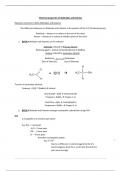
-
Chemical properties of Aldehydes and Ketones Reactions common to both Aldehydes and Ketones
- Exam (elaborations) • 45 pages • 2024
-
- $11.49
- + learn more
Chemical properties of Aldehydes and Ketones Reactions common to both Aldehydes and Ketones The difference between an Aldehyde and a Ketone is the position of the C=O (Carbonyl group). Aldehyde – always on a carbon at the end of the chain Ketone – Always on a carbon at middle carbon of the chain 1. BOTH Aldehydes and Ketones can be reduced Aldehyde reduced to Primary Alcohol Reducing agent = Sodium tetrahydroborate III (NaBH4) Ketone reduced to Secondary Alcohol Reduction Oxidisatio...
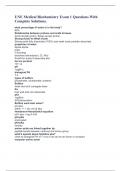
-
UNE Medical Biochemistry Exam 1 Questions With Complete Solutions.
- Exam (elaborations) • 8 pages • 2024
-
- $12.98
- + learn more
UNE Medical Biochemistry Exam 1 Questions With Complete Solutions. what percentage of water is in the body? 60% Relationship between protons and acids & bases Acids donate proton. Bases accept proton Strong Acids Vs Weak Acids Strong acids fully dissociate (100%) and weak acids partially dissociate properties of water dipole dipole polar H bonding dissolves electrolytes ( CL /Na) Small Kd- doesn't dissociate alot kw ion product 10^-14 pH -log[H+] biological PH 7.4 types of ...

-
BCH210 Runback Exam Questions| Already Answered| GRADED A+
- Exam (elaborations) • 23 pages • 2024
-
- $16.27
- + learn more
Monosaccharides - ANSWER-Soluble in water due to OH groups (always have either an aldehyde or ketone) Formula: (CH2O)n, where n is at least 3 Carbohydrate numbering - ANSWER-Always starts at the carbonyl; aldehyde is C1, ketone is C2 L vs. D isomers - ANSWER-Named based on left (l) vs. right (d) orientation of OH group Capital lettering given to highest-number chiral carbon; D is physiologically relevant Number of stereoisomers - ANSWER-2^x, where x is the number of chiral carbons x = tot...
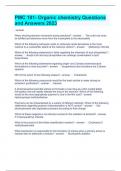
-
PMC 101- Organic chemistry Questions and Answers 2023
- Exam (elaborations) • 3 pages • 2023
-
- $16.49
- + learn more
PMC 101- Organic chemistry Questions and Answers 2023 When showing electron movement during reactions? The octet rule must be fulfilled and electrons move from the nucleophile to the electrophile Which of the following carboxylic acids or carboxylic acids derivatives is the most reactive to a nucleophilic attack at the carbonyl carbon? Methanoyl chloride Which of the following statements is false regarding the chemistry of acyl phosphates? Acetyl-CoA and acyl phosphates can und...
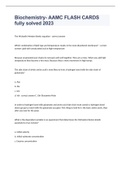
-
Biochemistry- AAMC FLASH CARDS fully solved 2023
- Exam (elaborations) • 10 pages • 2023
- Available in package deal
-
- $11.49
- + learn more
Biochemistry- AAMC FLASH CARDS fully solved 2023The Michaelis-Menten Kinetic equation - correct answer Which combination of lipid type and temperature results in the most disordered membrane? - correct answer Lipid with unsaturated acyl at high tempearture Because unsaturated acyl chains do not pack well well together. They are a mess. When you add high temperature they become a hot mess. Because they is more movement in high temps. The side chain of which amino acid is most likey to f...
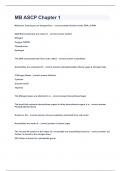
-
MB ASCP Chapter 1|2023 LATEST UPDATE|GUARANTEED SUCCESS
- Exam (elaborations) • 12 pages • 2023
-
Available in package deal
-
- $15.49
- + learn more
Molecular Techniques are designed for: Nucleic Acids, DNA, & RNA DNA Macromolecules are made of: Carbon Nitrogen Oxygen CNOPH Phosphorous Hydrogen The DNA macromolecules form units called: nucleotides Nucleotides are composed of: A phosphorylated ribose sugar & nitrogen base 4 Nitrogen Bases Adenine Cytosine Guanine ACGT Thymine The Nitrogen bases are attached to a: Deoxyribose Sugar The bond that connects deoxyribose sugars to other deoxyri...

-
BCHM 307 Exam Questions| Already Answered| GRADED A+
- Exam (elaborations) • 12 pages • 2024
-
- $11.48
- + learn more
The highest point in a reaction coordinate diagram represents _____. - ANSWER-the transition state Of the following ions, which would be most likely to participate in metal ion catalysis? - ANSWER-Zn2+ An organic molecule that is tightly bound to an enzyme and participates in an enzyme catalyzed reaction is specifically referred to as a _____. - ANSWER-prosthetic group Which of the following amino acids would be most likely found in the active site of an enzyme that uses acid-base catalysis...
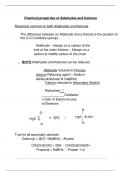
-
Chemical properties of Aldehydes and Ketones Reactions common to both Aldehydes and Ketones The difference between an Aldehyde and a Ketone is the position of the C=O (Carbonyl group). Aldehyde – always on a carbon at the end of the chain Ketone – Always
- Exam (elaborations) • 83 pages • 2024
-
- $15.99
- + learn more
Chemical properties of Aldehydes and Ketones Reactions common to both Aldehydes and Ketones The difference between an Aldehyde and a Ketone is the position of the C=O (Carbonyl group). Aldehyde – always on a carbon at the end of the chain Ketone – Always on a carbon at middle carbon of the chain 1. BOTH Aldehydes and Ketones can be reduced Aldehyde reduced to Primary Alcohol Reducing agent = Sodium tetrahydroborate III (NaBH4) Ketone reduced to Secondary Alcohol Reduction Oxid...
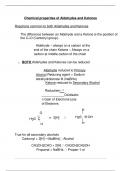
-
Chemical properties of Aldehydes and Ketones Reactions common to both Aldehydes and Ketones The difference between an Aldehyde and a Ketone is the position of the C=O (Carbonyl group). Aldehyde – always on a carbon at the end of the chain Ketone – Always
- Exam (elaborations) • 83 pages • 2024
-
- $15.09
- + learn more
Chemical properties of Aldehydes and Ketones Reactions common to both Aldehydes and Ketones The difference between an Aldehyde and a Ketone is the position of the C=O (Carbonyl group). Aldehyde – always on a carbon at the end of the chain Ketone – Always on a carbon at middle carbon of the chain 1. BOTH Aldehydes and Ketones can be reduced Aldehyde reduced to Primary Alcohol Reducing agent = Sodium tetrahydroborate III (NaBH4) Ketone reduced to Secondary Alcohol Reduction Oxid...
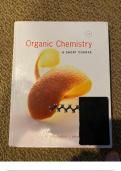
-
Organic Chemistry A Short Course 13Th Ed By Hart - Test Bank
- Exam (elaborations) • 260 pages • 2023
-
- $28.09
- + learn more
Chapter 3 -- Alkenes and Alkynes MULTIPLE CHOICE 1. Which of the following dienes can be classified as conjugated? A) CH3CH=C=CH2 B) CH3CH=CHCH=CH2 C) CH2=CHCH2CH=CH2 D) CH3CH=CHCH2CH2CH=CH2 E) CH2=C=CH2 ANS: B TOP: Alkenes and Alkynes: Nomenclature and Structure 2. Which of the following molecular formulas could not represent an alkene? A) C5H10 B) C7H14 C) C10H20 D) C27H56 E) C31H62 ANS: D TOP: Alkenes and Alkynes: Nomenclature and Structure 3. What...

Do you wonder why so many students wear nice clothes, have money to spare and enjoy tons of free time? Well, they sell on Stuvia! Imagine your study notes being downloaded a dozen times for $15 each. Every. Single. Day. Discover all about earning on Stuvia


